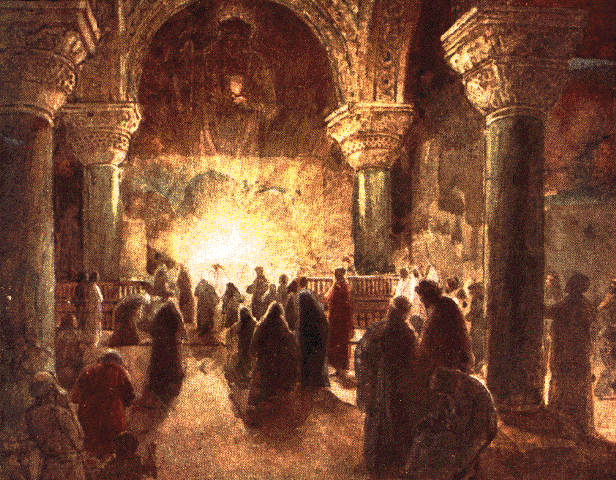
Pastor Smith sent this lovely excerpt from "Worship: A Royal Waste of Time" by . I thought you'd all enjoy it.
Also check out From Silence to Song, by Peter Liethart. This is an exegesis of 1 & 2 Samuel detailing how worship changed in Israel under David's leadership, and suggesting a framework for planning and evaluating our own changes in worship.
So, A Royal Waste of Time:
What is contemporary music? Do we mean choruses from Taize, pop songs, or
the esoteric music of Krzysztof Penderecki?
The value of their
metaphor of conducting a symphony is that it emphasizes the following aspects.
Unity. Even though a symphonic piece often has three or four
differing movements (usually one or two relatively faster segments and one or
two slower ones), these parts relate to each other. The same is true of any kind
of art; the elements of painting, similarly, must work together – with enough
variety for interest but not enough to make the piece incoherent. Even so the
components of worship must be congruent with each other.
Movements. A
symphonic piece varies widely in mood or tone or tempo between the individual
segments or portions of the piece. Similarly, the timbre of confession and
absolution is vastly different from the spirit in the hymns of praise.
Progression. There is a flow as the symphony progresses to its climax and
ending. So worship finds its high points in the Gospel reading and the Lord’s
Supper, but the liturgy that surrounds them makes a progression from the
entrance into worship to the dismissal into ministry.
The musical score.
There are specific notes to be played. So worship has a theme, usually generated
by the texts assigned for the day or chosen by the pastor. There are numerous
possibilities for the score – thousands of symphonies to choose from, a wide
range of texts. However, the performers must be faithful to the musical score,
even as pastors must be true to the text. (Obviously the analogy can’t be
stretched too far here because a musical score demands note accuracy far beyond
the requirements of worship. Perhaps we can avoid this problem by seeing the
composer of the score as the Church, with its arranger being a particular
congregation’s worship committee)
Diversity. Different symphonies require
vastly different instrumentation. Even so, worship calls for a variety of
musical sounds to display the rich splendor of God.
Numerous styles.
Symphonic music encompasses a wide diversity of sounds and flavors from al eras
and areas – from spare to lush harmonies, from romantic poignancy to marching
brassiness, from jazz to Latin or African rhythms, from European to Asian
melodies. Even so the music of the Church entails gifts from all people of God
throughout time and space.
Relationships. The conductor’s highest loyalty is
to the spirit of the music (for wich the written score and the composer are
valuable guides) – just as the worship leader’s superior authority is God (to
whom the community and the Scriptures are reliable escorts). Other relationships
are also essential in order for the symphony to be played well. A conductor
works together closely with the instrumentalists, just as the pastor and
musician in worship work with each other as team mates, and both work with the
worship committee to plan and carry out the best worship they can craft for the
sake of the particular congregation they serve.
Authority. The conductor
exercises the authority that is necessary for the performance – otherwise each
musician could go his or her own way – and the conductor is chosen for that
position because of his or her understanding of the composers, their music, and
how that music should be interpreted. Similarly, the pastor and musician are
mentors to the rest of the congregation in the art of worship, and out of their
expertise they exercise the authority of choosing and leading the elements of
worship.
3 comments:
Post a Comment